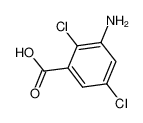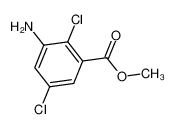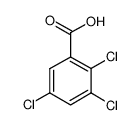| Product name | chloramben |
|---|
| Product number | - |
|---|---|
| Other names | 3-amino-2,5-dichlorobenzoic acid |
| Identified uses | For industry use only. Chloramben is used as a herbicide to control grasses and broadleaf weeds on soybeans, dry beans, lima beans, asparagus, pumpkins, squash, corn, tomatoes, peppers, and sweet potatoes. |
|---|---|
| Uses advised against | no data available |
| Company | MOLBASE (Shanghai) Biotechnology Co., Ltd. |
|---|---|
| Address | Floor 4 & 5, Building 12, No. 1001 North Qinzhou Road, Xuhui District, Shanghai, China |
| Telephone | +86(21)64956998 |
| Fax | +86(21)54365166 |
| Emergency phone number | +86-400-6021-666 |
|---|---|
| Service hours | Monday to Friday, 9am-5pm (Standard time zone: UTC/GMT +8 hours). |
Skin irritation, Category 2
Eye irritation, Category 2
Specific target organ toxicity – single exposure, Category 3
Carcinogenicity, Category 1B
2.2 GHS label elements, including precautionary statements| Pictogram(s) |   |
|---|---|
| Signal word | Danger |
| Hazard statement(s) | H315 Causes skin irritation H319 Causes serious eye irritation H335 May cause respiratory irritation H350 May cause cancer |
| Precautionary statement(s) | |
| Prevention | P264 Wash ... thoroughly after handling. P280 Wear protective gloves/protective clothing/eye protection/face protection. P261 Avoid breathing dust/fume/gas/mist/vapours/spray. P271 Use only outdoors or in a well-ventilated area. P201 Obtain special instructions before use. P202 Do not handle until all safety precautions have been read and understood. |
| Response | P302+P352 IF ON SKIN: Wash with plenty of water/... P321 Specific treatment (see ... on this label). P332+P313 If skin irritation occurs: Get medical advice/attention. P362+P364 Take off contaminated clothing and wash it before reuse. P305+P351+P338 IF IN EYES: Rinse cautiously with water for several minutes. Remove contact lenses, if present and easy to do. Continue rinsing. P337+P313 If eye irritation persists: Get medical advice/attention. P304+P340 IF INHALED: Remove person to fresh air and keep comfortable for breathing. P312 Call a POISON CENTER/doctor/…if you feel unwell. P308+P313 IF exposed or concerned: Get medical advice/ attention. |
| Storage | P403+P233 Store in a well-ventilated place. Keep container tightly closed. P405 Store locked up. |
| Disposal | P501 Dispose of contents/container to ... |
none
3.Composition/information on ingredients 3.1 Substances| Chemical name | Common names and synonyms | CAS number | EC number | Concentration |
|---|---|---|---|---|
| chloramben | chloramben | 133-90-4 | none | 100% |
Consult a physician. Show this safety data sheet to the doctor in attendance.
If inhaledIf breathed in, move person into fresh air. If not breathing, give artificial respiration. Consult a physician.
In case of skin contactWash off with soap and plenty of water. Consult a physician.
In case of eye contactRinse thoroughly with plenty of water for at least 15 minutes and consult a physician.
If swallowedNever give anything by mouth to an unconscious person. Rinse mouth with water. Consult a physician.
4.2 Most important symptoms/effects, acute and delayedACUTE/CHRONIC HAZARDS: This compound emits toxic fumes when heated to decomposition.
4.3 Indication of immediate medical attention and special treatment needed, if necessary Absorption, Distribution and Excretion... /STUDIES IN A LACTATING COW SHOWED THAT OVER/ A PERIOD OF 4 DAYS, DIETARY CHLORAMBEN (5 PPM IN DAILY RATION) WAS RAPIDLY EXCRETED IN URINE (88%) & FECES (5%). NO RESIDUES WERE DETECTED IN THE MILK. APPROX 18% OF CHLORAMBEN IN URINE WAS PRESENT AS UNKNOWN CONJUGATED MATERIAL.
5.Fire-fighting measures 5.1 Extinguishing media Suitable extinguishing mediaFires involving this material can be controlled using a dry chemical, carbon dioxide or Halon extinguisher.
5.2 Specific hazards arising from the chemicalFlash point data for this compound is not available, but it is probably combustible.
5.3 Special protective actions for fire-fightersWear self-contained breathing apparatus for firefighting if necessary.
6.Accidental release measures 6.1 Personal precautions, protective equipment and emergency proceduresUse personal protective equipment. Avoid dust formation. Avoid breathing vapours, mist or gas. Ensure adequate ventilation. Evacuate personnel to safe areas. Avoid breathing dust. For personal protection see section 8.
6.2 Environmental precautionsPrevent further leakage or spillage if safe to do so. Do not let product enter drains. Discharge into the environment must be avoided.
6.3 Methods and materials for containment and cleaning upPick up and arrange disposal. Sweep up and shovel. Keep in suitable, closed containers for disposal.
7.Handling and storage 7.1 Precautions for safe handlingAvoid contact with skin and eyes. Avoid formation of dust and aerosols. Avoid exposure - obtain special instructions before use.Provide appropriate exhaust ventilation at places where dust is formed. For precautions see section 2.2.
7.2 Conditions for safe storage, including any incompatibilitiesStore in cool place. Keep container tightly closed in a dry and well-ventilated place.
8.Exposure controls/personal protection 8.1 Control parameters Occupational Exposure limit valuesno data available
Biological limit valuesno data available
8.2 Appropriate engineering controlsHandle in accordance with good industrial hygiene and safety practice. Wash hands before breaks and at the end of workday.
8.3 Individual protection measures, such as personal protective equipment (PPE) Eye/face protectionSafety glasses with side-shields conforming to EN166. Use equipment for eye protection tested and approved under appropriate government standards such as NIOSH (US) or EN 166(EU).
Skin protectionWear impervious clothing. The type of protective equipment must be selected according to the concentration and amount of the dangerous substance at the specific workplace. Handle with gloves. Gloves must be inspected prior to use. Use proper glove removal technique(without touching glove's outer surface) to avoid skin contact with this product. Dispose of contaminated gloves after use in accordance with applicable laws and good laboratory practices. Wash and dry hands. The selected protective gloves have to satisfy the specifications of EU Directive 89/686/EEC and the standard EN 374 derived from it.
Respiratory protectionWear dust mask when handling large quantities.
Thermal hazardsno data available
9.Physical and chemical properties| Physical state | Purplish white powder or light purple solid. |
|---|---|
| Colour | COLORLESS CRYSTALLINE SOLID |
| Odour | ODORLESS |
| Melting point/ freezing point | 194-201ºC |
| Boiling point or initial boiling point and boiling range | 373.2ºC at 760mmHg |
| Flammability | no data available |
| Lower and upper explosion limit / flammability limit | no data available |
| Flash point | 179.5ºC |
| Auto-ignition temperature | no data available |
| Decomposition temperature | no data available |
| pH | no data available |
| Kinematic viscosity | no data available |
| Solubility | In water:700 mg/L (25 ºC) |
| Partition coefficient n-octanol/water (log value) | log Kow = 1.11 |
| Vapour pressure | 3.12E-06mmHg at 25°C |
| Density and/or relative density | 1.607g/cm3 |
| Relative vapour density | no data available |
| Particle characteristics | no data available |
no data available
10.2 Chemical stabilityRAPIDLY DECOMPOSED BY LIGHT
10.3 Possibility of hazardous reactionsNonflammableCHLORAMBEN reacts with sodium hypochlorite solutions .
10.4 Conditions to avoidno data available
10.5 Incompatible materialsno data available
10.6 Hazardous decomposition productsDISASTER HAZARD: WHEN HEATED TO DECOMP, IT EMITS HIGHLY TOXIC FUMES SUCH AS /HYDROGEN/ CHLORIDE AND NITROUS OXIDES.
11.Toxicological information Acute toxicity- Oral: LD50 Rat oral 3,500 to 5,620 mg/kg
- Inhalation: no data available
- Dermal: no data available
no data available
Serious eye damage/irritationno data available
Respiratory or skin sensitizationno data available
Germ cell mutagenicityno data available
Carcinogenicityno data available
Reproductive toxicityNo information is available on the reproductive or developmental effects of chloramben in humans. Reduced ossification of skeletal bones was reported in the fetuses of rats orally exposed to chloramben.
STOT-single exposureno data available
STOT-repeated exposureno data available
Aspiration hazardno data available
12.Ecological information 12.1 Toxicity- Toxicity to fish: no data available
- Toxicity to daphnia and other aquatic invertebrates: no data available
- Toxicity to algae: no data available
- Toxicity to microorganisms: no data available
STUDIES WITH SOIL MICROFLORA INDICATED THAT BREAKDOWN OF AMIBEN OCCURRED...& THAT THE CARBOXYL WAS CLEAVED SLOWLY BUT STEADILY.
12.3 Bioaccumulative potentialBased on a measured water solubility of 700 mg/L at 25°C(2) and a regression derived equation(1), a BCF of 15.34 can be estimated for Amiben(SRC). This BCF value suggests that Amiben may not bioconcentrate in aquatic organisms(SRC).
12.4 Mobility in soilAmiben is expected to have anionic properties in most soil systems under environmental conditions (pH 5-9). When a column of Ella island soil type (pH 3.8, 1.6% organic matter, 82.7% sand, 12.2% silt, and 5.2% clay) was perfused for 160 days with a microbial medium containing 5.7 and 26.9 ppm (14)-COOH-labelled Amiben, 1.4 ppm (24.6%) and 5.0 ppm (18.5%) Amiben adsorbed to the soil, respectively. When a column of Kewaunee clay soil type (pH 6.4, 3.8% organic matter, 14% sand, 35.1% silt, and 48.7% clay) was perfused for 160 days with a microbial medium containing 5.7 and 26.9 ppm 14COOH-labelled Amiben, 0.6 ppm (11.1%) and 2.6 ppm (9.8%) Amiben adsorbed to the soil, respectively. When a column of Poygan silty clay soil type (pH 7.2, 10% organic matter, 6% sand, 58.9% silt, and 33.6% clay) was perfused for 160 days with a microbial medium containing 5.7 and 26.9 ppm 14COOH-labelled Amiben, 1.4 ppm (24.6%) and 5.4 ppm (20.1%) Amiben adsorbed to the soil, respectively. Therefore, soil pH and organic matter content are the primary factors controlling Amiben adsorption with higher adsorption to soil occurring either at a low pH with a low organic matter content or at a neutral pH with a high organic matter content(1).
12.5 Other adverse effectsno data available
13.Disposal considerations 13.1 Disposal methods ProductThe material can be disposed of by removal to a licensed chemical destruction plant or by controlled incineration with flue gas scrubbing. Do not contaminate water, foodstuffs, feed or seed by storage or disposal. Do not discharge to sewer systems.
Contaminated packagingContainers can be triply rinsed (or equivalent) and offered for recycling or reconditioning. Alternatively, the packaging can be punctured to make it unusable for other purposes and then be disposed of in a sanitary landfill. Controlled incineration with flue gas scrubbing is possible for combustible packaging materials.
14.Transport information 14.1 UN Number| ADR/RID: UN2588 | IMDG: UN2588 | IATA: UN2588 |
| ADR/RID: PESTICIDE, SOLID, TOXIC, N.O.S. |
| IMDG: PESTICIDE, SOLID, TOXIC, N.O.S. |
| IATA: PESTICIDE, SOLID, TOXIC, N.O.S. |
| ADR/RID: 9 | IMDG: 9 | IATA: 9 |
| ADR/RID: III | IMDG: III | IATA: III |
| ADR/RID: no | IMDG: no | IATA: no |
no data available
14.7 Transport in bulk according to Annex II of MARPOL 73/78 and the IBC Codeno data available
15.Regulatory information 15.1 Safety, health and environmental regulations specific for the product in question| Chemical name | Common names and synonyms | CAS number | EC number |
|---|---|---|---|
| chloramben | chloramben | 133-90-4 | none |
| European Inventory of Existing Commercial Chemical Substances (EINECS) | Listed. | ||
| EC Inventory | Listed. | ||
| United States Toxic Substances Control Act (TSCA) Inventory | Listed. | ||
| China Catalog of Hazardous chemicals 2015 | Not Listed. | ||
| New Zealand Inventory of Chemicals (NZIoC) | Not Listed. | ||
| Philippines Inventory of Chemicals and Chemical Substances (PICCS) | Not Listed. | ||
| Vietnam National Chemical Inventory | Not Listed. | ||
| Chinese Chemical Inventory of Existing Chemical Substances (China IECSC) | Not Listed. | ||
| Creation Date | Aug 12, 2017 |
|---|---|
| Revision Date | Aug 12, 2017 |
- CAS: Chemical Abstracts Service
- ADR: European Agreement concerning the International Carriage of Dangerous Goods by Road
- RID: Regulation concerning the International Carriage of Dangerous Goods by Rail
- IMDG: International Maritime Dangerous Goods
- IATA: International Air Transportation Association
- TWA: Time Weighted Average
- STEL: Short term exposure limit
- LC50: Lethal Concentration 50%
- LD50: Lethal Dose 50%
- EC50: Effective Concentration 50%
- IPCS - The International Chemical Safety Cards (ICSC), website: http://www.ilo.org/dyn/icsc/showcard.home
- HSDB - Hazardous Substances Data Bank, website: https://toxnet.nlm.nih.gov/newtoxnet/hsdb.htm
- IARC - International Agency for Research on Cancer, website: http://www.iarc.fr/
- eChemPortal - The Global Portal to Information on Chemical Substances by OECD, website: http://www.echemportal.org/echemportal/index?pageID=0&request_locale=en
- CAMEO Chemicals, website: http://cameochemicals.noaa.gov/search/simple
- ChemIDplus, website: http://chem.sis.nlm.nih.gov/chemidplus/chemidlite.jsp
- ERG - Emergency Response Guidebook by U.S. Department of Transportation, website: http://www.phmsa.dot.gov/hazmat/library/erg
- Germany GESTIS-database on hazard substance, website: http://www.dguv.de/ifa/gestis/gestis-stoffdatenbank/index-2.jsp
- ECHA - European Chemicals Agency, website: https://echa.europa.eu/


























